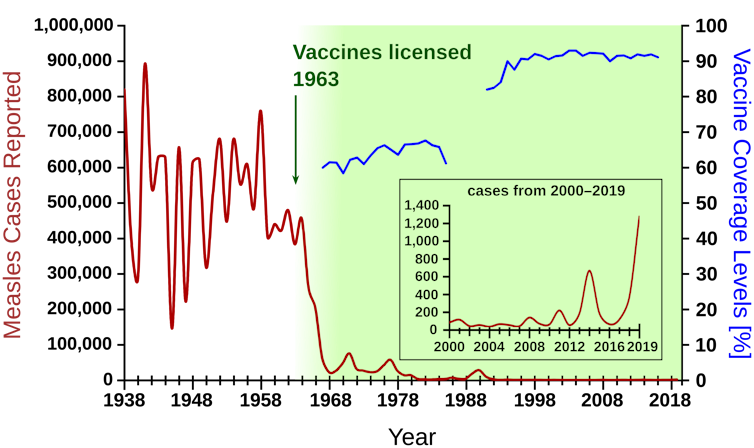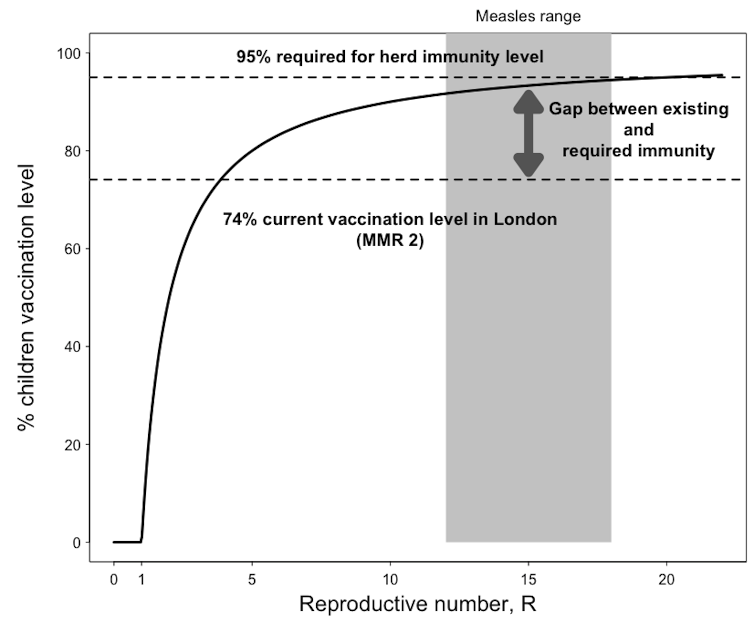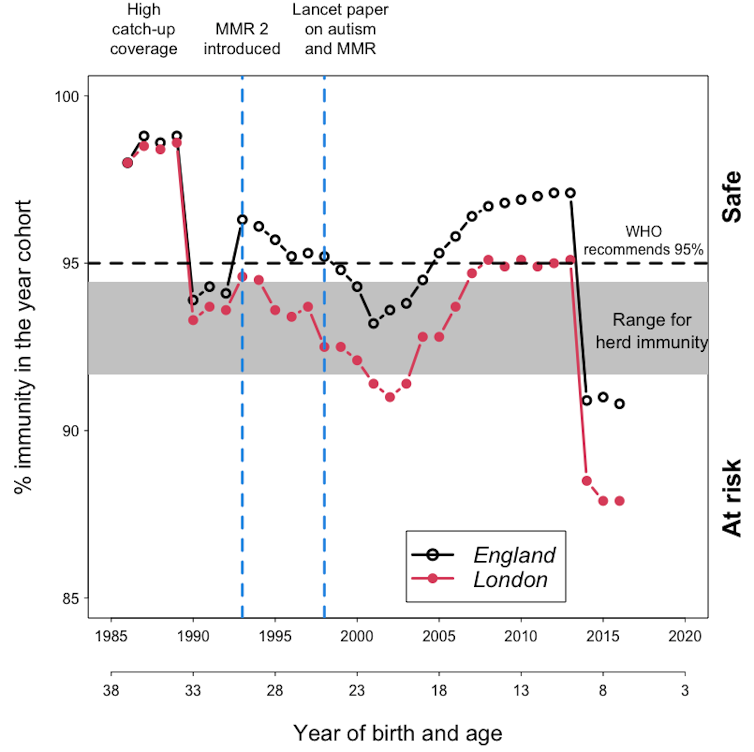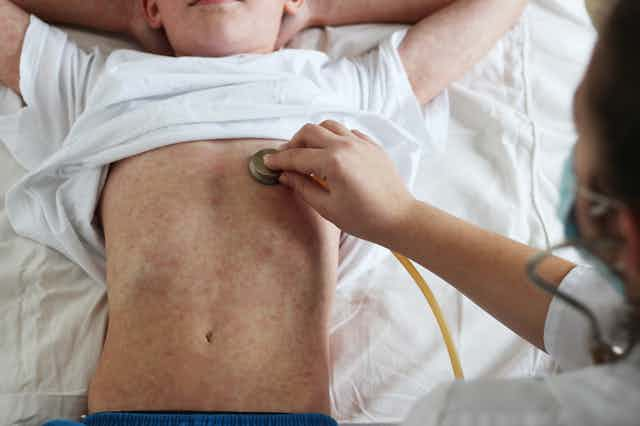The UK Health Security Agency (UKHSA) has warned of an increased risk of measles outbreaks, particularly in London.
Although the probability of a large epidemic is still considered to be low elsewhere in the UK, the UKHSA’s projections suggest the capital could see 40,000 to 160,000 cases, with hospitalisation rates of 20%-40%.
For 60 years, measles has been preventable by a widely available vaccine, so why is London facing a potential disaster now?
The answer lies in faltering vaccine coverage, particularly since the late 1990s, but exacerbated by COVID pandemic.
Measles is a viral infection that primarily affects children but can also occur in adults. It can cause serious complications, particularly in people with weakened immune systems.
The measles virus spreads through respiratory droplets from an infected person, making it easily transmissible in close quarters such as schools, hospitals, and public transport. It’s known to be one of the most infectious pathogens affecting humans.
The basic reproduction number, R, for measles, is estimated to be between 12 and 18. This means one infected child can pass on the disease to 12 to 18 other children in a completely susceptible population.
The effective reproduction number, Re, takes into account the proportion of contacts who are not susceptible, either because they have already had measles or have been vaccinated. If the Re is larger than one, the disease spreads.
Before measles vaccines became available, almost everybody over five would have had the disease, which for most meant lifelong immunity. But complications like encephalitis or pneumonia caused many deaths. Even today, thousands die from measles globally every year – mostly unvaccinated young children.
Vaccination campaigns have been remarkably successful in reducing the number of measles cases. Mass vaccination programmes started in the 1960s and quickly suppressed the spread in most developed countries. The measles shot is a “sterilising” vaccine, which means it not only prevents illness, but also transmission.
Measles cases in the US, 1938–2019

We don’t actually need to vaccinate every single person against measles for everybody to be protected. By vaccinating a large enough proportion of the population, we can lower the Re below one, effectively “starving” the pathogen of new hosts. The population then reaches “herd immunity”.
Mathematical modelling, taking in the virus’ reproduction number and other factors, allows us to estimate the level of vaccination needed to reach and maintain herd immunity.
For measles to be eliminated, between 90% and 95% of the population should be immune (either from vaccination or infection).
Herd immunity could be lost if we don’t keep vaccinating children who are born susceptible to measles. Two doses of the measles, mumps and rubella (MMR) vaccine are needed – the first at 12 months and the second at age five – for effective protection.
The current levels of MMR coverage in England, particularly in London, are well below the 95% threshold.
Vaccination levels needed to maintain herd immunity

MMR vaccination levels across different age groups in London

The UK has never reached the 95% level of MMR coverage recommended by the World Health Organization (WHO) to eliminate measles, although it has come close enough to prevent a repeat of the large outbreaks that regularly occurred before the 1960s.
However, a drop in vaccination rates in the late 1990s meant repeated revivals of the virus. This drop is often linked to the publication of Andrew Wakefield’s Lancet paper linking the MMR vaccine to autism, which has since been debunked.
Then, in 2017, the WHO declared that the UK had eliminated measles, but this was not maintained. Cases subsequently started occurring more frequently in areas with particularly low vaccination coverage. An outbreak in England between 2017 and 2018 saw a nearly fourfold increase in confirmed cases. Other European countries had similar problems.
The COVID pandemic has seen vaccination levels drop further, creating a perfect storm of low immunity levels.
Some children born since 2015 who were going to be given their second MMR shot during the COVID pandemic missed it. These groups of children are at particular risk, as they are now at school, where they can easily catch the virus.
As well as COVID lockdowns limiting access to routine healthcare, vaccine hesitancy and outright anti-vaxxer attitudes have likely been magnified by COVID vaccine misinformation.
Estimated immunity levels for different age groups, London and England

While only three-quarters of eligible five-year-olds in London have received their second MMR dose, immunity levels are not the same across all age groups. The UKHSA has sought to work out immunity levels in different age groups to better understand the risk of outbreaks.
The UKHSA combined the proportion of vaccinated people in different age groups with vaccine efficacy (93% after the first dose and 97% after two). It also accounted for the misclassification of unvaccinated and under-vaccinated people.
The resulting immunity levels are unevenly distributed across ages, as seen in the graph above. Most adults 55 or over are likely to have had measles when they were young. Children born between the start of the vaccination programme and the late 1980s were given a catch-up in 1994 and 1996 and are relatively safe. But children born in the late 1990s and early 2000s are potentially at high risk, as is the most recent, post-2015 cohort.
With its consistently low vaccination levels, London is more likely to face an outbreak than the rest of the UK. Counting how many people would need to become infected to fill in the “immunity gap” gives the worst-case estimate of 160,000 cases for the capital.
Read more: Measles outbreaks and political crises go hand in hand
Some 1,053 cases of measles were reported in England and Wales over the past year, and we could see more. Most of the new disease outbreaks can be controlled by emergency vaccination and management of contacts. But loss of immunity makes the virus escape more likely and could lead to large, uncontrollable outbreaks.

